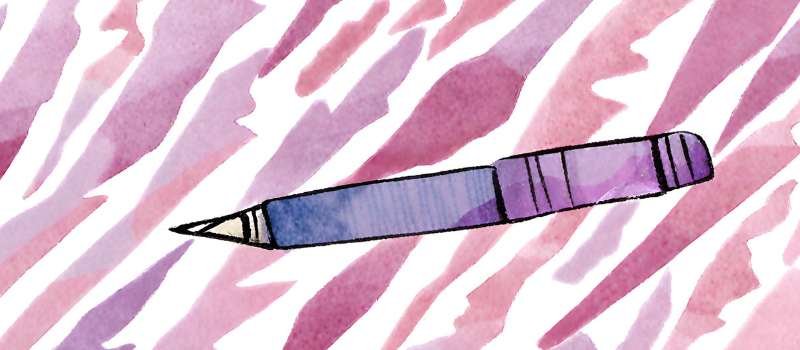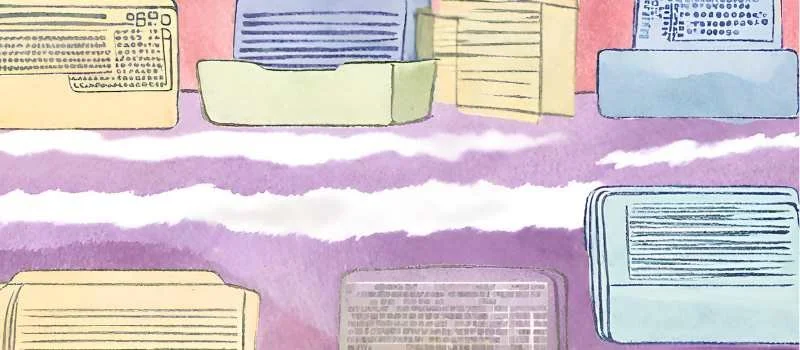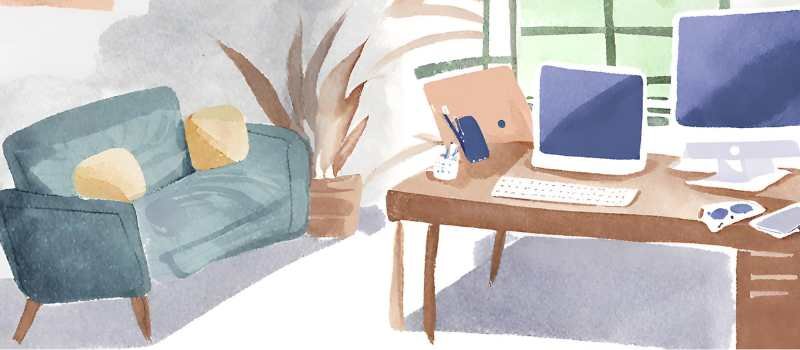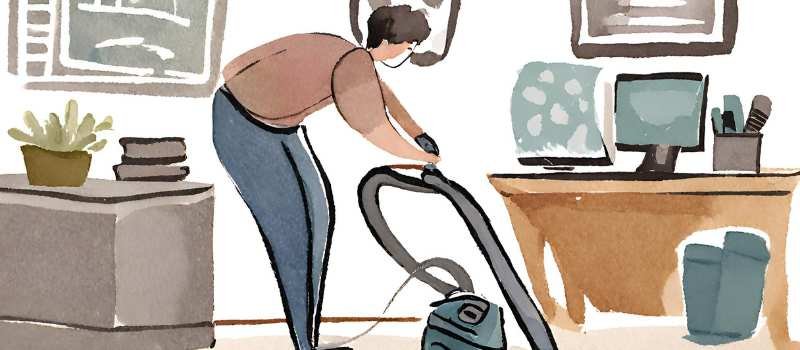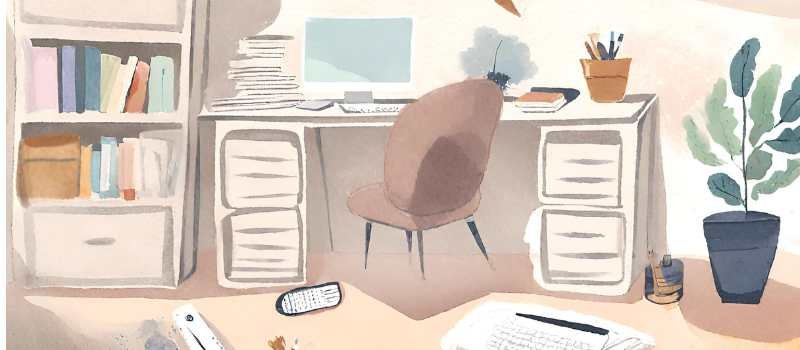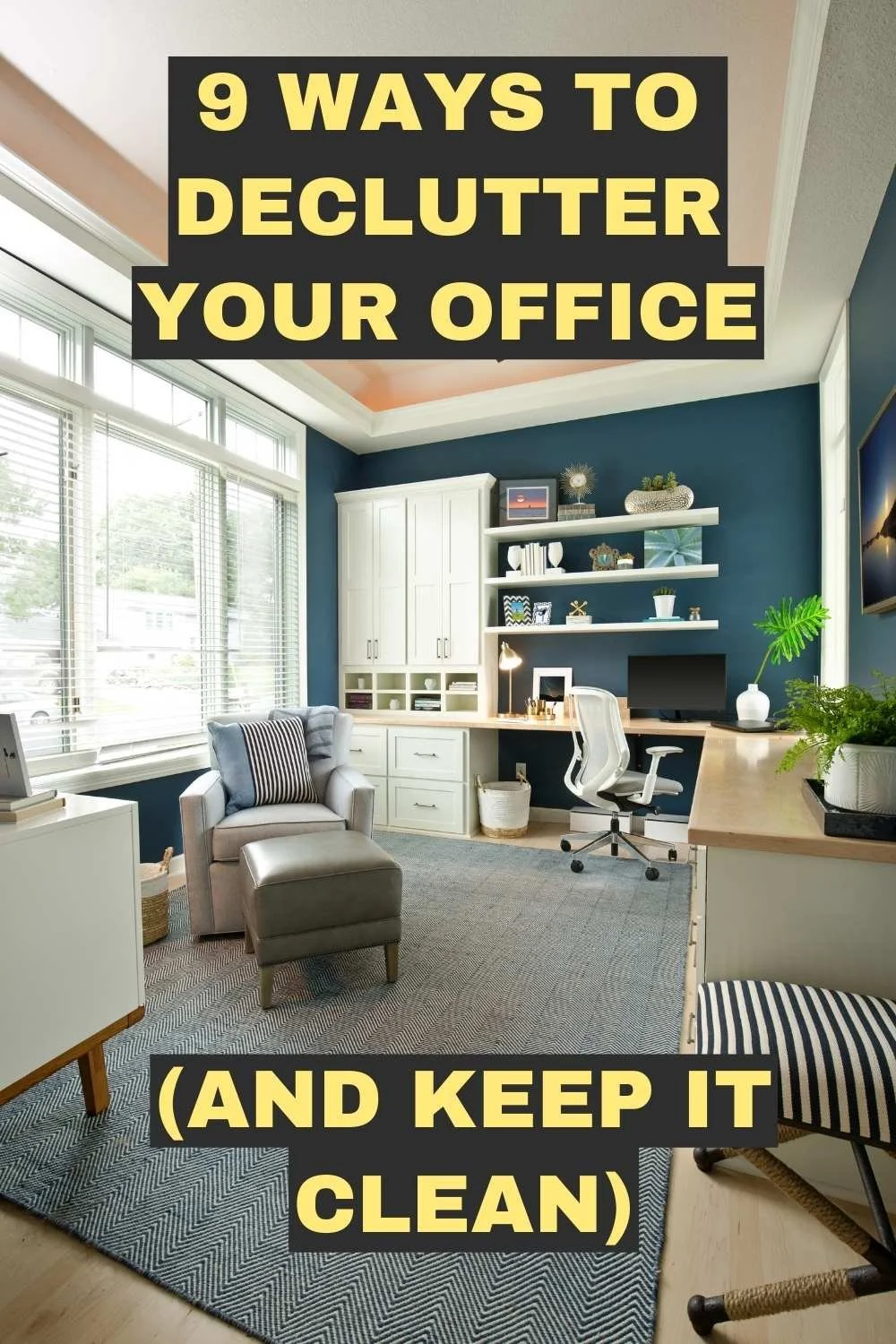9 Ways to Quickly Declutter Your Office (And Keep It Clean)
/Welcome to the ultimate guide to decluttering your office - for a quick fix and keeping it that way once and for all.
Ever stared at your cluttered office and felt like your brain was in a similar state of chaos? You're not alone.
Let's dive into why tidying up isn't just about making your space look good, but also about supercharging your work mojo.
Why a Tidy Office Matters
Having a tidy desk is more than just a visual treat. It sets the stage for a productive workday and can significantly impact your mental well-being.
Boosted Productivity: No more wasting time searching for that one document or pen. Everything's right where you need it.
Mental Clarity: A clean space equals a clear mind and reduced stress. Say goodbye to that overwhelmed feeling every time you sit down to work.
Aesthetics: Let's be honest, a clean desk and organized work area just look good. Plus, it gives off a professional vibe, especially on those unexpected video calls.
Quick Guide to Decluttering Your Home Office
If you're short on time and just want the essentials, here's a quick guide to get your home office decluttered in just one weekend. Dive deeper into the article for more detailed tips and tricks!
Your Weekend Decluttering Plan
| Day | Task | Action Steps |
|---|---|---|
| Day 1 | Paperwork & Surfaces | Gather all papers and categorize them into trash, recycle, shred, file, or act. Purge unnecessary items ruthlessly. Set up a basic filing system and digitize documents where possible. |
| Day 2 | Tech & Final Touches | Discard outdated gadgets and manage cables for a cleaner look. Update computer files and ensure they're backed up. Designate specific areas for tech items. Install shelves or pegboards for additional storage. Finish by cleaning, dusting, and adding personal touches to your space. |
And once everything’s tidy, here’s some pointers to help you keep it that way:
| Maintenance Aspect | Description |
|---|---|
| Daily Habits | Stick to daily or weekly tidying routines. |
| Scheduled Decluttering | Set aside time for regular decluttering sessions. |
| Paper Management | Stay on top of your paperwork to prevent accumulation. |
| Designated Spots | Always return items to their proper places. |
| Continuous Purging | Regularly evaluate and discard items you no longer need. |
Let’s go deeper, with lots more info on de-cluttering your office once and for all, plus some of my top recommended products to help you along the way.
10 Ways to Declutter Your Office
Ready to start de-cluttering? Let’s start with my first suggestion.
1. The "No Brainer" Toss-Outs
Before diving deep into organizing, let's start with the easy stuff. Here are items you can (and should) get rid of without a second thought.
Broken Pens: If it's been on your desk for months and you haven't fixed it, you probably never will. Toss it.
Outdated Tech: That old calculator or ancient phone? If you haven't used it in the past year, it's time to say goodbye.
Mystery Cords: If you don't know what it's for, chances are you don't need it.
Elevate your desk game with a top-rated desk organizer. It's got compartments for everything, ensuring a place for every item and every item in its place. And if you've got drawers, don't forget about dividers – they're a game-changer for those miscellaneous items.
2. Wall Storage and Workspace Serenity
Elevating your storage game isn't just about the horizontal; it's time to think vertical. Let's explore how wall storage can be your ticket to a serene workspace.
The Vertical Advantage:
Why limit yourself to the confines of your desk when you have an entire wall to play with?
Space-Saver: Wall-mounted shelves and pegboards free up valuable desk real estate, giving you more room to work.
Easy Access: No more rummaging through drawers. With wall storage, your essentials are always within arm's reach.
Aesthetic Appeal: Beyond functionality, wall storage can be a design statement. Choose shelves that match your office vibe, and you've got decor that's both stylish and practical.
A ladder shelf offers the perfect solution to storage needs in a home office.
3. Digital Declutter: Beyond Physical Space
In today's tech-driven world, clutter isn't just about physical items strewn across your desk. Digital clutter can be just as overwhelming, if not more. Let's dive into the world of digital decluttering and discover the joys of a paperless office.
The Digital Document Revolution:
Gone are the days of overflowing file cabinets and stacks of paperwork. Welcome to the era of digital documents.
Space-Saver: Storing documents digitally frees up physical space, making your office look cleaner and more organized.
Easy Retrieval: With a proper naming system and folder structure, finding that specific document becomes a breeze.
Eco-Friendly: Going digital means less paper waste, making it a win for you and the environment.
The Paperless Office Perks:
The idea of a paperless office isn't just a trend; it's a game-changer.
Enhanced Security: Digital documents can be encrypted, password-protected, and backed up, ensuring they're safe from theft or damage.
Cost-Efficient: Save money on paper, ink, and storage solutions.
Accessibility: Access your documents from anywhere, anytime, as long as you have an internet connection.
Digitization: The Path to a Cleaner Workspace:
Digitizing notes and documents isn't just about reducing physical clutter; it's about streamlining your workflow.
Quick Edits: Need to make changes? Digital documents can be edited without the need for reprints.
Collaboration: Share documents with colleagues in real-time, making teamwork more efficient.
Reduced Distractions: With fewer papers around, you're less likely to get sidetracked, helping you maintain focus.
If you're looking to embark on your digital decluttering journey, the Epson WorkForce ES-50 is a fantastic place to start. This high-speed scanner not only captures documents in crystal-clear quality but also comes with intuitive software to help you organize and categorize your scans.
4. Cable Management for a Streamlined Workspace
Ever tripped over a stray cable or spent ages trying to identify which cord goes where? We've all been there. Proper cable management isn't just about aesthetics; it's about creating a safer and more efficient workspace.
The Tangle Trouble:
Cords and cables snaking around can quickly turn your office into a chaotic mess. Here’s why it’s time to sort them:
Safety First: Loose cables are tripping hazards. Keeping them organized ensures you won't accidentally take a tumble.
Efficiency Boost: No more wasting time trying to trace back a cable to its source. Everything is neat, tidy, and easily accessible.
Aesthetic Appeal: A clutter-free floor and desk space look more professional and are more pleasant to work in.
Cable Organization Tools:
There's a whole world of tools out there designed to help you keep your cables in check.
Cable Sleeves: These handy tools bundle your cords together, keeping them neat and out of the way.
Cable Clips: Perfect for ensuring that frequently used cables, like phone chargers, are always within reach but never underfoot.
Under-Desk Trays: These trays keep power strips and excess cable lengths hidden away, ensuring a clean look for your workspace.
Mystery Cords: The Silent Clutter Culprits:
We all have them - those mystery cords that we're too afraid to throw away "just in case." It's time to tackle them head-on.
Identification: Use labels or colored ties to mark each cable, so you always know what it's for.
Purge: If you haven't used a cord in over a year and can't identify its purpose, it's probably safe to let it go.
Storage: For those essential but infrequently used cables, consider a dedicated storage box or bag.
For those eager to dive into the world of cable management, the "CableMaster Organizer Kit" is a game-changer. This comprehensive kit includes sleeves, clips, labels, and more, ensuring that you have everything you need to transform your tangled mess into a streamlined workspace.
5. Zone Creation and Workspace Productivity
Ever found yourself searching for a pen for what feels like hours? Or maybe you've misplaced an important document right before a big meeting? The solution might be simpler than you think: creating designated zones in your workspace.
Why Zones Matter:
Creating specific areas for different tasks isn't just about organization; it's about boosting your productivity and reducing daily frustrations.
Efficiency Boost: Knowing exactly where everything is means less time searching and more time working.
Mental Clarity: A well-organized space can lead to a well-organized mind. When everything has its place, it's easier to focus on the task at hand.
Task Segmentation: By designating zones, you mentally prepare yourself for the task you're about to undertake, whether it's brainstorming, writing, or making calls.
The Art of Designating Zones:
Think of your workspace as a mini-city, with each zone serving a unique purpose.
The Command Center: This is your main workspace, where you'll spend most of your time. It should have all the essentials within arm's reach.
The Research Nook: A space dedicated to brainstorming and research. Consider having a whiteboard or corkboard here for jotting down ideas.
The Tech Hub: A zone for all your tech gadgets, chargers, and perhaps even a docking station.
The Relaxation Corner: Every workspace needs a spot to take a breather. Whether it's a comfy chair with a book or a space for your coffee machine, make sure you have a zone to relax.
Productivity and Organization: Two Sides of the Same Coin:
It's no secret that an organized workspace can lead to increased productivity. But it's not just about decluttering; it's about creating a space that aligns with your work habits and needs. By creating zones tailored to your tasks, you're setting yourself up for success.
To kickstart your zone creation, consider a 3-in-1 charging station to declutter your space for charging all of your gadgets.
6. Decluttering Hacks for a Quick Fix
We've all been there: unexpected video calls, surprise visits, or just one of those days when the clutter seems to multiply on its own. But fear not! With a few genius hacks up your sleeve, you can transform your workspace from chaotic to calm in no time.
Why Quick Fixes Matter:
Sometimes, you don't have a whole day to declutter. Quick fixes are all about instant gratification, giving you a tidier space in a fraction of the time.
Instant Boost: A quick declutter can instantly elevate your mood and boost productivity.
Maintain Order: Regular quick fixes can prevent clutter from piling up, making more extensive decluttering sessions less frequent and daunting.
3 Simple Tips to Keep On Top of Office Clutter:
When you’ve a busy work life to tend to, these tips will help you keep clutter at bay:
The One-Minute Rule: If a task takes less than a minute (like putting a pen back or filing a document), do it immediately.
Zone-Based Cleaning: Instead of trying to declutter the entire office, focus on one zone at a time.
Daily Declutter Ritual: Spend just 5 minutes at the end of each day tidying up. It'll make a world of difference the next morning.
Quick Fixes for Long-Term Benefits:
While these hacks offer quick solutions, their impact can be long-lasting. By integrating these simple tips into your daily routine, you'll find that maintaining an organized office becomes second nature.
7. Professional Help: When to Call in the Experts
Let's face it, sometimes decluttering and organizing can feel like an insurmountable task. Whether it's years of accumulated paperwork, a complex office layout, or just the sheer magnitude of the mess, there are moments when you might wonder if you're in over your head. That's where the pros come in.
Why Consider Professional Help?
Hiring a professional organizer isn't about admitting defeat; it's about recognizing when you need a little extra expertise. Here's what they bring to the table:
Expertise and Experience: Professional organizers have seen it all. They come equipped with tried-and-true strategies to tackle even the most chaotic of spaces.
Efficiency: With their systematic approach, what might take you days or even weeks can be accomplished in a fraction of the time.
Objective Perspective: An outsider's view can often pinpoint solutions that might not be obvious to you. They can provide fresh insights into space utilization and decluttering strategies.
Accountability: Just like a personal trainer at the gym, having a professional by your side can keep you motivated and on track.
Signs It's Time to Call in the Experts:
Overwhelm: If just the thought of decluttering sends you into a panic, it might be time for some professional assistance.
Recurring Clutter: If you find yourself decluttering the same spaces over and over without lasting results, a professional can help identify the root causes.
Big Life Changes: Moving, merging offices, or downsizing? These transitions can benefit from an organizer's touch.
Time Constraints: If you're too busy running your business or managing other responsibilities, hiring help can be a time-saving solution.
Making the Most of Professional Help:
If you decide to hire an expert, be open to their suggestions and be prepared to make some tough decisions about what stays and what goes. Remember, they're there to help you create a more functional, serene workspace.
If you’re considering professional help but unsure where to start, simply Google “Professional office organizers near me.”
8. Regular Maintenance and Office Efficiency:
A decluttered office isn't just a one-time achievement; it's a continuous journey. Just like a garden that needs regular tending, your workspace requires consistent attention to remain a haven of productivity. And trust us, the rewards are well worth the effort.
Why Regular Maintenance Matters
Boosted Productivity: A clean and organized workspace minimizes distractions, making it easier to focus on tasks at hand.
Mental Clarity: A tidy desk can lead to a tidy mind. Without clutter clouding your space, your mental clarity can soar, leading to better decision-making and creativity.
Time Savings: Ever spent ages searching for a misplaced document? Regular decluttering ensures everything has its place, saving you precious time in the long run.
The Power of Before and After Photos:
There's something incredibly satisfying about seeing tangible proof of your hard work. Taking "Before" photos of your cluttered space and comparing them to the "After" shots once you've tidied up can be a powerful motivator. Here's why:
Visual Progress: It's a clear, undeniable record of how far you've come.
Motivation: On days when clutter starts creeping back in, those photos can be the nudge you need to set things right.
Accountability: Sharing your progress with friends or colleagues can provide an added layer of motivation to maintain your organized space.
9. Tips for Ongoing Maintenance:
Daily Tidy-Up: Spend the last 5 minutes of your workday organizing your desk. It ensures you start the next day on the right foot.
Weekly Check-In: Dedicate some time each week to go through papers, files, and other items that might have accumulated.
Monthly Deep Clean: Once a month, give your office a thorough cleaning. Dust, vacuum, and wipe down surfaces.
For those looking to keep their office in tip-top shape, a robot vacuum takes the effort out of keeping your office floor space clean and dust-free.
Conclusion: The Transformative Power of Decluttering for Work-at-Home Success
Let's circle back to where we started: the undeniable impact of decluttering on your work-at-home experience. In the digital age, where our homes often double as our offices, creating a space that fosters productivity, creativity, and well-being is paramount. A cluttered environment isn't just an eyesore; it's a mental roadblock. Each misplaced paper or tangled cable subtly chips away at your focus and efficiency.
Remember, decluttering isn't just about aesthetics. It's about crafting an environment where you can thrive. A space where each item has a purpose and a place. A space that, when you step into it, signals to your brain, "It's time to get things done."
FAQs: Your Guide to a Clutter-Free Office
Navigating the world of office decluttering can be overwhelming. Here are some frequently asked questions to guide you on your journey to a more organized workspace.
What does a clutter-free office environment entail? A clutter-free office is a workspace that's organized, tidy, and free from unnecessary items, allowing for increased focus and efficiency.
How can I maintain a clean office consistently? Regular organization routines, combined with efficient storage solutions, can help you maintain a pristine workspace. It's also essential to evaluate and purge items you no longer need periodically.
Why is mental space crucial in an office setting? Mental space refers to the clarity and peace of mind you achieve when your surroundings are organized. A decluttered office can significantly enhance concentration, reduce stress, and boost overall well-being.
How does brand representation relate to office organization? The state of your office can influence how clients and colleagues perceive your brand. A tidy and organized workspace projects a professional image and can positively impact business perception.
Are there any efficient tools or hacks for decluttering? Yes, there are numerous decluttering advice and office organization tips available. From cable labels for cord control to electronic records systems for a paperless office, the options are vast. See above!
How often should I evaluate my office for efficiency? Regular checks, perhaps monthly or quarterly, can help ensure your workspace remains streamlined and productive. This involves reassessing your workflow, workspace management, and overall system.
What's the difference between decluttering and minimalism in an office setting? While both aim for reduced clutter, decluttering focuses on removing unnecessary items, whereas minimalism is about simplicity and might involve fewer possessions overall, leading to a minimalist office design.
How can I achieve a tidy workspace and maintain it? Regular office cleaning, combined with habits like returning items to their designated spots and continuous clutter reduction, can help maintain a tidy workspace.
Want more? Check out these articles for products to help you build the best home office setup in the world:
About the Author
Andrew Macarthy has worked from home for over a decade. He is a social media consultant and the author of the #1 Amazon Web Marketing Bestseller, 500 Social Media Marketing Tips - with over 150,000 copies sold to date.





